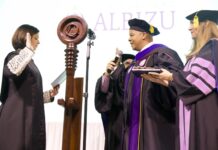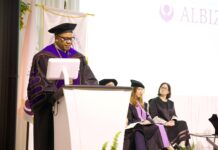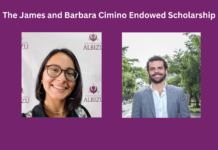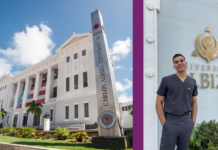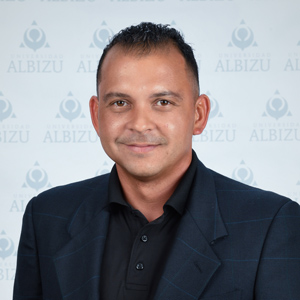
Different physiological conditions can cause a patient to have eating difficulties or be physically unable to complete the food-swallowing process. In other cases, there may be psychological circumstances that hinder the process of eating. Dr. Alberto Avilés Muñoz, DHSc, CCC-SLP, speech pathologist and assistant professor of the Speech Pathology Program at the Mayagüez University Center of Albizu University, explained to Albizu Magazine why it is crucial for specialists to have a comprehensive panorama of the physical and mental condition of a patient with this type of disorder.
It is essential to understand the difference, explains Dr. Avilés Muñoz, “because there are two aspects of eating disorders, and not all eating disorders are dysphagia. Dysphagia largely involves interruption of the passage of food due to neurological, organic, or mechanical causes of the bolus through the tract, which may be the mouth, throat, or esophagus. These elements mark the stages of swallowing, from taking the food to the mouth through chewing. When this swallowing process cannot be completed, it is a case of dysphagia, which can be multifactorial. The cause may be cervical spurs, or cervical spondylosis, patients who have suffered strokes, or progressive neurological disorders such as Alzheimer’s, dementia, or Parkinson’s disease.”
A different case is that which has to do with psychogenic etiologies, meaning a disease or disorder caused by psychological or emotional factors. Dr. Vélez Muñoz explains that in these cases, “we are talking about eating disorders, and to address these disorders, we work with certain aspects of eating. This type of disorder can be seen in children with developmental deficiencies, or for example, a patient with dementia who does not recognize that he has to eat and rejects or spits out food because his cognitive state does not allow him to participate in the eating process. Other types of eating disorders are addressed from a psychology perspective, such as anorexia, bulimia, or children who only eat foods that do not provide nutritional value.” This type of behavior in children is treated as a possible eating disorder, but it is not necessarily considered a case of dysphagia from a medical perspective.
“A diagnosis of dysphagia today implies that there is a problem in orogenic mechanical abilities, that is, the physical ability to chew and swallow food”
“It is what we commonly know as the “picky” child because it used to be seen as a problem of bad behavior, and in other times, the child was even left without eating to discipline him. However, it has been discovered children with sensory processing problems lead them to dislike or resent certain foods or refuse to eat because they cannot tolerate the consistency or texture of some foods. “This may be the case of children and young people with autism, who sometimes show a high level of selectivity with food,” Dr. Vélez further explains. This type of disorder is an eating disorder, but it is not a case of dysphagia in the strict sense of the term. A diagnosis of dysphagia today implies that there is a problem in orogenic mechanical abilities, that is, the physical ability to chew and swallow food.
The expert in swallowing disorders adds that “if we start from the premise that eating is a sensory and motor process, which covers the aspects of flavor, texture, temperature and the motor effects to be able to swallow, it can be concluded that many of these patients have an eating disorder. But sensory dysphagia has not been recognized until now.”
Dr. Vélez Acosta also explains that in the case of these children, it is necessary to determine if the eating disorder can affect their development. “At that point is when a speech pathologist intervenes and offers therapy so that the child can accept different consistencies and textures of foods, learn to tolerate them, and increase the range of foods they eat. Special attention is also paid when this type of eating disorder coexists with developmental disorders, such as Down Syndrome or muscular dystrophies.”
Dr. Vélez Acosta highlights that the patient’s medical history must be analyzed to identify the cause of swallowing problems and determine if there is a physical disorder or psychological circumstances that should be examined. “In certain cases, specialists can conduct evaluations to determine if there is a problem with swallowing or feeding. A psychologist will see the case from different perspectives. But to diagnose dysphagia, instrumental tests are used, such as endoscopic evaluation that looks at the pharyngeal stage of swallowing and which is used in both children and adults. There is also a type of test called video fluoroscopic swallowing, performed in coordination with a radiologist and a speech pathologist. “Colored food is used with some contrast method to obtain x-rays that allow us to see the swallowing process so that the speech pathologist can report the findings.”
“Comprehensive therapy that addresses the physical problems and the emotional condition is the most recommended”
The specialist points out, however, that both in the case of people with dysphagia and those who suffer from eating disorders, psychological support may be necessary to address the effects that eating difficulties can have on emotional health. “We must understand that the feeding process is a basic function of human beings and is also a reason to socialize in numerous contexts. In patients with dysphagia, it is important to attend to the emotional aspect since the difficulty they have in eating can lead them to develop an aversion to eating in public environments. Many people with these disorders choose not to eat food in social settings. In these instances, psychological support and pathology therapy are provided.” Likewise, the specialist explains that therapy for people with eating disorders can be provided to people with eating problems whose cause is not directly related to swallowing. “For example, there are people who have lost limbs or are Parkinson’s patients who cannot grasp cutlery or face great difficulty doing so. The eating experience can be extremely complicated for these people, who prefer not to do it publicly. Technology such as electronic cutlery is already being developed to assist in the process, but that is considered another eating disorder. In these cases, occupational therapy is also offered, and psychological support may be advisable.”
Comprehensive therapy that addresses the physical problems and the emotional condition is the most recommended in these cases, both in those whose origin is a physical disorder and in those in which it is an eating disorder with psychological causes or derived from other conditions. However, as a reflection, Dr. Vélez states that “there is still a lot of room for research about the correlation between dysphagia and psychological components, and there is too much to study and understand. Because the language of the psychologist is different from that of the pathologist.” What we should aspire to, says the specialist, “is for the psychologist to understand the vision and scope of the pathologist and for the pathologist to understand the psychologist’s vision.” Achieving greater visibility will allow us to establish links and a collaborative effort that results in a better understanding of these conditions. This will allow the development of comprehensive treatment and therapy options that address different aspects to improve people’s well-being.



